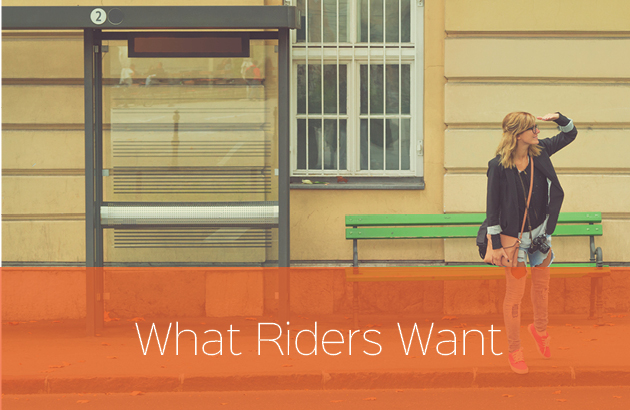What Do Transit Riders Want

Agencies have many options for where they can invest funding. However, some of these investments are more likely than others to have a positive impact on ridership.
So, what do riders want? To help answer this question, we can look to Who’s on Board 2016, a research report published by TransitCenter. Based on the survey responses of 3,000 transit riders from 17 regions across the U.S., the report analyzed what people value in transit.
What Matters to Riders and What Doesn’t?
When survey respondents were asked to rank the importance of 12 possible service improvements, those related to time, frequency and cost took top spots, followed by bus shelters and real-time information.
What fell to the bottom of the list? High-tech ‘extras’ like USB ports and free Wi-Fi barely registered with respondents. Cosmetic improvements like new sidewalks and plants leading to bus stops also weren’t seen as very important. Some service factors didn’t rank very highly either. The survey suggests that riders are more willing to accept late buses and a longer walk to the bus stop than they are willing to accept long wait times and slow rides.
Because transit riders value increased service frequency and faster travel times above all else, it makes sense to focus improvement efforts in these areas.
Using Technology to Give Riders What they Want
Using ridership data collected through CAD/AVL technology and onboard fareboxes, agencies can learn how to optimize their routes. Route optimization can save agencies money by reducing driver-hours. It can also benefit riders by shortening trips, and when routes are shortened, the time that was saved can be used toward increasing service frequency on popular routes. All these benefits can be realized without putting more vehicles on the road.
Candace Eudaley, Director of Transit Operations at The Jule, said that it took them only four months worth of data to determine what they needed to do to optimize routing. With the Jule’s re-structured schedule, riders enjoyed ride times that were 50% shorter for most trips. Jule riders responded favourably to the improved routing. According to Candace, “after that point we saw, I think, upwards to 20% increases per month in ridership, just from those changes.”
Cost was the third most important service improvement in the TransitCenter survey. It should come as no surprise that riders want better service, but do not want to pay more for it. How can agencies avoid ticket price increases? If an agency can save money through route optimization, that can help with expenses. Route optimization can save agencies money by reducing driver-hours and removing extraneous vehicles from service. At the Jule, they were able to save about $100,000 dollars in one year, through route optimization alone. Agencies can increase revenue by getting more funding through government sources. Back-office reporting software can help agencies win grants through data-driven reports that show why they should receive the funding.
A lot of riders also think it’s important to have shelters at bus stops. This makes sense – who wants to wait outside for a long period of time without shelter from the elements? Bus shelters can improve rider satisfaction, but if service frequency is improved, the importance of shelters may be reduced.
Riders also ranked real-time passenger information systems as being fairly important. Passenger information systems give riders access to trip data based on CAD/AVL technologies, including predicted arrival times. This information may be displayed to riders via digital signs at bus stops, or through a smartphone app or web portal. Passenger information systems allows riders to reduce their wait-time by planning their arrival at the bus stop for just a few minutes before the bus arrives. Apps are especially useful for this purpose, because riders can access the app while on the go.
Passenger information systems allow riders to better plan their day and waste less time. Studies have also shown that when riders do not have access to real-time passenger information, they estimate their wait time as longer than it actually is. Therefore, deploying the technology may lead riders to perceive that their wait times are shorter even if the service has not changed.
Riders like passenger information systems, but does that translate into increased ridership? Research suggests that it does. A 2015 study on New York City’s bus system found that over the course of three years, ridership increased by 2% thanks to their new passenger information system. This meant over $6.3 million in added revenue over the three year period.
The research is unanimous. Spending on extras like Wi-Fi and cosmetic improvements are unlikely to boost ridership. Whereas investing in technologies like CAD/AVL, scheduling and reporting software, and real-time passenger information systems are likely to boost ridership while also helping agencies trim costs.

